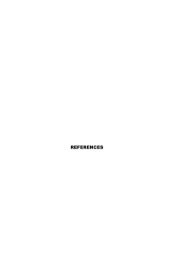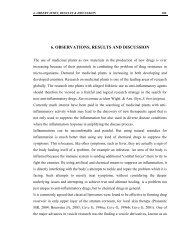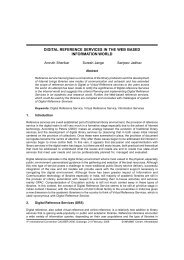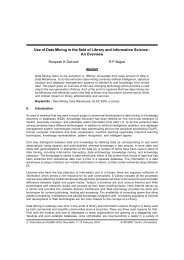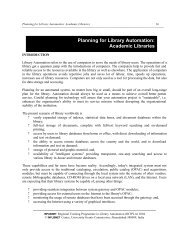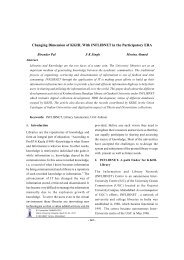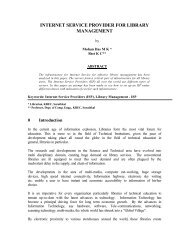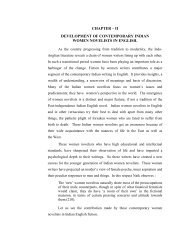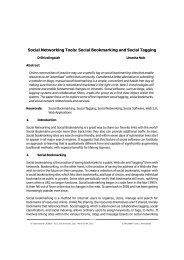Abstract - DSpace@INFLIBNET Home - INFLIBNET Centre
Abstract - DSpace@INFLIBNET Home - INFLIBNET Centre
Abstract - DSpace@INFLIBNET Home - INFLIBNET Centre
You also want an ePaper? Increase the reach of your titles
YUMPU automatically turns print PDFs into web optimized ePapers that Google loves.
165A Sharable Content Object Reference Model (SCORM) Initiation:An ExperienceSarbjot KaurSunil Aggarwal<strong>Abstract</strong>The era of information and communication technology has created web-basedlearning environment and led to the digital and virtual educational systems. With e-learning mode classrooms have been changed to virtual classroom. Libraries canbe seen in the midst of so many innovations, progressing towards their new visionand goal to be the part of the virtual world in its true sense, where there is nobarrier between information and information seekers. Libraries are undergoingphase of developmental changes even unaware of so many challenges. Today’shybrid libraries are favouring electronic learning objects and facilitating end userswith the help of innovative semantic interoperability. Extensive use of online resourcesin the developing countries like India, which is geographically very vast and varied,provoked the authorities of educational system to incorporate web-based learningsystem to facilitate the distant user who are physically deprived from the learningin form of education. Various institutions and databases are providing access to e-learning objects, though they have their own ways for creating metadata. Theprecision value is quite low at standardized retrieval points which also vary frominterface to interface, therefore, to share all these resources and for their easyexchange, a set of rules and specifications are required. Here comes SharableContent Object Reference Model in picture, a set of rules and specification developedby Advanced Distributed Learning for setting the compatibility between e-learningobject and learning management systems or tools. This paper has been dividedinto three sections. First one discusses the holistic nature of problem in terms ofspatial changes in library architecture, change in the definition of learning objectand perception and training problems of the librarians in the current scenario.Second section includes the six case studies with respect to websites of Google,Wikipedia, Merlot Open source learning project, Massachusetts institute ofOpen Access to Textual and Multimedia Content :Bridging the Digital Divide, January 29-30, 2009 © <strong>INFLIBNET</strong> <strong>Centre</strong>, Ahmedabad and CEC, New Delhi
166Technology, social sciences research network and consortium of educationalcommunication. Third section carries over the insight of the first two sections tothrow light on the key role of standards for the proper integration of learningmanagement systems specifically Sharable Content Object Reference Model andthe level of awareness and preparation vis-à-vis the same.This paper has been motivated by a quite familiar sense of discomfort that permeatesamong the professionals of library science and knowledge seekers (of cyberspace)particularly living in non-metropolitan areas and those educational institutions serving thevernacular sections of the society. This is accentuated by persistent failures of librariansof such institutions to go beyond the superfluous automation of library managementsystems and continuous digital divisions in the sociological structures of knowledge.Internet has created a feeling that knowledge belongs to one and all without the barriersof culture, country, caste and creed. Information in various multimedia formats is beinguploaded on the websites which are accumulated by search engines as well as socialnetworking systems on the Internet for optimum retrieval. Though, the metadata usedby these electronic objects providers need to be standardized in more efficient andeffective way for information sharing.The focus of this study is not towards providing the solutions rather it is meant to createa multi-dimensional framework of a professional working in this area right from thebottom to the top. The main theme of this paper is distributed among three sections.1. Section one broadly discusses the conceptual framework as well as difficultiesof librarians sitting in the peripheral areas both in digital and developmental sense.2. Section two tries to collate six case studies of the best possible and popularmethods of accessing and retrieval of information through Google search engine,wikipedia, www.merlot.org, www.mit.edu, social sciences research network and coupleof years back launched learning object repository of CEC-UGC.3. Section three assimilates the experiences of first two sections into an analyticalapproach that views SCORM with relative scorn, as well as wonder. SCORM is astandard for knowledge packaging with respect to e-content. It is an initiative
167popularized by Advanced Distributive Learning (ADL) Project launched by theDepartment of Defence, United States of America. Today, within India, it may notbe a popular choice but within next few years, it does carry the seeds of extremepopularity in the information world. This section actually deals with predicament ofIndian situation vis-à-vis this possible paradigm shift.Section OneDevelopment in computers, microelectronics and communication technology have radicallychanged the library and information environment. The days of stand-alone librarieshave gone and shifted to library and information network available via the Internet,which provides users with a seamless connection to internet based services. Virtuallibraries can be rightly said ‘libraries without walls’ where there is no architectural andphysical existence of libraries. It will exist as virtual space in the millions of computersintegrated by internet.Electronic objects are prominently being used but still so many fundamental issues areyet to be established: the proper definition of learning object; the form of standard pathways of knowledge where knowledge does not getlost anytime or anywhere; and the terms of proper designing of learning management system.Let us discuss these issues one by one. The primary task of a librarian 4 has undergonea paradigm shift. The spatial architecture has gone beyond the control because informationcan be uploaded from anywhere to the web. It is like an ocean where there are somany canals of information in which traffic is both way possible. The paradox is thatthere are many pathways but there is no standard gateway. (Even if there are some,there is lack of consensus on them).The system of storing and retrieving of bibliographical details are inadequate on theweb. The methodology of finding information varies from one Learning Object (LO) toanother. Before we discuss that, we need to have a little bit clarity about the concept oflearning object. 5
168“Currently, there are as many definitions of LOs as there are users, like:1. “For this standard (Draft Standard for learning Object Metadata v6.1), a learningobject is defined as any entity , digital or non digital, that may be used for learning,education or training’’ (IEEE Learning Technology Standards Committee)2. “…a learning Object … (is) ‘any digital resource that can be reused to supportlearning. This definition includes anything that can be delivered across the networkon demand , be it large or small………(Wiley 2002)3. “(A learning Object) is defined as the smallest independent structural experiencethat contains an objective, a learning activity and an assessment.’’(L’Allier 1997)To be precise, a librarian needs to give more focus on the learning object repositoriesrather than focusing on established standards for books, magazines, journals etc. Theactual state of library automation system is quite unsatisfactory because the entireprocess of automation has been narrowed down to making only computerized versionsof library catalogues and issue/return registers. Even the high speed bandwidth that isthe crux of today’s libraries is mainly present within the computer laboratories.The problem does not end here rather a totally different dimension of libraries has beenemerged by using state-of-the-art technology i.e. when a learning object, knowledgesystem, course, presentation or paper is created, it can be uploaded to the internetimmediately but without the participation of a qualified librarian who knows the archivalimportance of digital data, this venture can be quite short-sighted as well as wronglypremised. Harmonization of web accessibility standard is the key to making an accessibleweb. It is the way forward to exchange and share the information without limitation ofgeographical space. Now the issue of metadata becomes the issue of cross cultural,cross frontier, cross continental and universal.Section TwoIt is quite essential to carry over the conceptual framework in the form of the mostfrequent and relevant attempts of data location particularly at the local level becausethe difference between the praxis and theory is quite interdependent in this case.Generally, the attempts are focused in following ways:
169IIIIIIIVA vague search of the conceptLocating the learning object in its multimedia formPrecise location of scholarly material e.g. research paper, book etc.Replacing the curriculum based material with online materialFollowing case studies have been made while searching for electronic learning objects infew common search engines, databases and websites.Case – I: Search in GoogleIt is quite a normal practice that typing a keyword in the Google search column tends tobe providing something as results but in almost all the cases, user has a very vagueidea about what he/she wants to search, which gives thousands and millions of resultswhile searching. It is like an opening of an archive which is yet to be catalogued. Aftersearching through a dozen odd entries, if user finds desired information and feel satisfiedbut if it does not happen, then user just stops attempting further in view of derecognizingthe vast capacity of the Google search engine.By knowing the fact Google has given various search options like Google Images,Google Videos, Google Maps, Google News, Google Books, Google Software, GoogleScholar and much more. Even within each of them, there are lot many options. e.g.Google Videos has animation, educational, movies, music videos, sports, entertainment,technology etc sub-columns within it. A very rough search into many of these optionsrevealed that there are more than four million entries within just the videos’ segment.Just within educational sub-head, there are around 2.6 lakh entries. After acquiringYoutube.com, the number of these entries is increasing exponentially. This is somethingthat going to take information load in the internet to much beyond even Petabytes (10Xtrillion X trillion) but this mega info-structure is actually a relational database 6 . Wheneverany user needs to locate desired information, he/she receives a product of this relationaldatabase where entries are coming out in the atomized forms. It is an index of eachword and its relationship to nearby words in the scanned objects. It is not what a seekermight have been in need. He/she cannot type the holisticity of one’s need both in termsof objectives and net output. The methodology of a search engines breaks the whole
170need into the minute fungible objects which though helps in locating but still remainsdistant from the goal. In nutshell a search engine is something upon which librarysciences can depend only partly not fully.Furthermore, within Google 7 , the extent of reach within its branches of web, images,videos, maps etc, the ultimate output varies a lot. For example, we tried two entries asthe keywords in the search box. Initially, we filled the URL www.cec-ugc.org in theGoogle Web. It took us directly to the home page of the same. Then, we tried thesame in the Google Images. It took us directly to the images column of the same sitebut when we filled the same keyword in the Google Videos, we could find only zeroresult.Then tried another keyword from indexing of e-content module in the masscommunications category of CEC-UGC in all the three searches made in Google web,images and videos, where, we got no result. It naturally led to the conclusion thatsearch engine technology is in initial stage and evolving. This is primarily because of thefact that this technology has not built itself on the premise of a ‘wholesome learningobject’; rather, it does not bother to define a learning object. The atomization of thekeyword itself is a limitation that puts the learner into a position where he/she will have todepend upon one’s own rational capacities to look for what is expected. Even theadvanced search options don’t solve the problem quite cleverly rather they only minimizethe extent of the search to a certain level. The sophistication and specification of thechoice should be much sharper so that a knowledge object gets accessible within theshortest and simplest manner.Case – II: WikipediaThe second case relates with Wikipedia 8 . Over the last three years, the online andopen-source encyclopeadia has turned out to be the world’s largest source of immediateinformation. It is a multi-lingual and a multinational collaboration of a vast number ofpeople. Just in English, it has an entry of 1.5 million articles in addition to lakhs more inmany continental languages. More or less, the peer review methodology developedover the period, generally gives a great deal of good results. The associated hyperlinksare an excellent reference material for a user/learner. Not just that, wikipedia has many
171sister projects quite on the lines of Google in the form of wikiquotes, wiki creativecommons, wikimedia, wikinews, wikivarsity, etc. It is quite natural on the part of cyberknowledge to acquire a meta character whether it be Google or Wikipedia. Again, we arenearing the levels of the immensity of archives but does this information qualify for aknowledge management system of a flat world.In Wikipedia, when learner starts looking for resources in Hindi language, where theyend up with the limited information. As far as the information about cultures of developingand least developed countries are concerned, paucity of the same can be felt again.The overall bias was more of Anglo-American. It was an experience of “free yet notfree”. As far as the methodology of search is concerned, it is more or less simplifiedfrom an alphabetically designed search to a keyword based search. It is online encyclopediawith open source qualities. Here, again the search is atomized and does not qualify for acyber library management system.Case – III: Merlot’s websiteThe third case study is related with the website of Merlot - www.merlot.org. 9 Thiswebsite is dedicated to open source learning where disciplinary information is in the formof course material available either full or part. It covers more than a dozen disciplinesparticularly of social sciences. It has thousands of articles, papers and course ware inform of PDF files, video lectures and MS PowerPoint presentations in its archives. Someof them do belong to the copyright status but a majority belongs to the copy-leftstream. The thematic structure of most of the contributions is quite specific, analyticalas well as critical. Even the controversial themes and positions are also being taken upwhich generally are avoided in Wikipedia but merlot does not have the range or depth ofresources as they were in the earlier two. Even if there is an issue of cross-linkingdifferent entries in the repository, things are not that well organized. The directorysystem is not intra-linked seriously. Accessibility of information is not directly proportionalto the instructional designs of knowledge e.g. the video lectures are lying independent ofother elements of this design e.g. glossary, frequently asked questions, quizzes, summary,feedback or even other hyperlinks/references. They lack the interactivity of a knowledgesystem. Internet carries information but a library management system shall seek it tobe translated into an applied design of some set objectives.
172Case – IV: Massachusetts Institute of TechnologyThe next case study is the website of Massachusetts Institute of Technology. 10 Sections‘Humanities and Social Sciences’ and chose ‘Political Science’ were explored and thenfurther chose ‘Globalization, Fall 2005 in it. It was with a great sense of relief that a topquality material seemed within reach at simple click of a button. There were aroundeight sub-heads within this e.g. discussion, readings, assignments, download etc. Whenclicked on download, there was again a reference for downloading the zip file whichseemed too difficult for a novice. Even it was a text file only. It was a course materialbut it was not organized into a total learning object. It was a disaggregated piece oflearning. The learner would have to choose one’s own method of suitability to make fulluse of such material. He may prefer to go for a full print-out of that material beforereading. Even, the depth expected of the material was foreclosed because a lot of goodstuff has been put into the proprietary category and is available only through paymentmode. Still it needs to be developed as a dynamic learning management system thattakes care of multimedia needs of a learning object. That leaves the territory of alibrarian quite untouched because simply putting paper text on internet is not going tosolve the problem of e-content.Case – V: Social Sciences Research NetworkThe fifth case is that of the Social Sciences Research Network. 11 Perhaps, this particularwebsite needs not much reference. The reason is that it does not design itself as alearning management system rather it is an archive of e-journals and e-papers. Thiswebsite provides researchers subject-specific, term-specific, period-specific papers bothin free and paid format. A vast chunk of these papers is in the open source. Thekeyword search can be title or abstract-based. For teachers and researchers who don’thave access to costly journals and periodicals in their institutions, this site is an excellenttreasure of scholarly information. Quite on the similar lines, the internet provides serviceslike subject guides and research guides discussed in detail in Netspeak 12 The mainproblem is that it is like a vast tower of knowledge. What a library science professionalseeks for is the existence of bridges between these towers of knowledge and these areyet to be strongly and consensually built.
173Case – VI: Consortium of Educational CommunicationThe sixth and final case study is related with the Consortium of EducationalCommunication 13 , New Delhi. It needs to be mentioned that CEC-UGC is an interuniversitybody working under the aegis of HRD ministry of Govt. of India. It aims tobuild a virtual university, one of its own kinds in India. Through its ‘learning objectrepository’ various video lectures embedded into that. The beauty of this truth is limitedby the fact that this site does not have such examples in plenty. It is a magnificent siteof learning but this is not an in-depth site because well-trained e-content developers arerequired to create such a good knowledge base. This demands a lot of training ofteachers. Of course, CEC is focusing on that but there are miles and miles to go. Butanyhow, it has given a lead what others can pursue. It does not have an interface withother websites who are into similar quests. It can be quite helpful to knowledge seekers.One can observe various problems, achieving an understanding from broad to specifictowards a solution to these problems- regarding absence of universal archival format,common pathway and definition of learning object in the new realm of multimedia. Aneed arises of an international standard which can help in making a learning object trulyuniversal so that it can be accessed by anybody in the world which is generally known asglobalization of the web. The objective of globalization is to make a web and learningobject “linguistically and functionally useful to more than one country’’ 14These case studies illustrate that Internet has expanded so fast and so deep into therealms of knowledge that it faces an uphill task of proper organization. The currentmethods being undertaken to access or retrieve information are of limited nature interms of their usefulness particularly after the emergence of e-content in its new multimediaformat. The digital methods are fast replacing the writing methods associated with pen,paper etc, they are also replacing the way we communicate with one another and theyare also redesigning the way classroom lectures are delivered. The six case studiesemerged in an era where bandwidth problems discouraged the integration of text-basedcontent into video and audio formats. With the introduction of new Internet Protocols,emergence of technologies like Wifi, WiMax, EDGE etc., things have reached a stagewhere e-content with its own standards needs to be focused. This takes to the final
174portion of this paper i.e. the third section where discussion is on the SCORM, theemerging de-facto standard 15 in the e-learning format.Section ThreeThe SCORM published by the ADL project, is an emerging standard for e-learningcontent. It was initiated in 1997 by the Department of Defence (U.S.A) in the form ofAdvanced Distributed Learning. The ADL initiative 16 is preparing for a world wherecommunication networks and personal delivery devices are pervasive and inexpensive,as well as transparent to the users in terms of ease of use, bandwidth and portability.SCORM is a suite of technical standards that enable web-based learning systems tofind, import, share, reuse, and export learning content in a standardized way. There isa set of services that launches learning content, keeps track of learner progress, figuresout in what order learning objects are to be delivered, and reports student masterythrough a learning experience. This smart learning management system tries to judgethe competency of a learner in respect to his understanding towards the learner object.SCORM enables complex directed learning experiences that go far where most of theweb content consists of simple hyperlinks from one page to another. Not just that, thiscan cater to both categories of learning – synchronous (virtual classroom technologybased upon video teleconferencing and video tele-training where students have to bepresent at specific times at specific places) and asynchronous (instruction and decisionaiding anytime anywhere) methods.SCORM content is made of so-called Shareable Content Objects (SCO) aggregated intoa content package. The SCOs are a specialized type of learning object. Each SCO is aunit of content that can be delivered to a learner by a SCORM-compliant learningmanagement system. In order to create a useful learning experience, SCORM consistsof three things: Overview – about the model, vision and future. Content Aggregation Model- how to put learning content together so it can bemoved and reused. Run Time Environment- how content is launched and the learner’s progress istracked and reported back.
175On Nov 16, 2006 17 , the ADL initiative has undergone a formal agreement with theAviation Industry CBT committee (AICC), IMS Global Learning Consortium Inc. (IMS)and the Institute of Electrical andElectronics (IEEE) to permit their work and derivatives within the SCORM 2004 3 rdEdition. In addition to that, it shall also pave its way into the formal submission 18 ofSCORM into the International Organization for Standardization (ISO). Then what shouldbe the bothering issues for the academic communities?1. Is there enough awareness about the need of standards within the realm of e-content so that a debate around SCORM can be built?2. Are teachers trained in the development of e-content with enough mastery ofthe new tools of knowledge packaging which are totally different from the ‘Chalk andTalk’ method being used for ages?3. How to make the role of a librarian central to these new emerging trendsbecause the domain of teachers will be creating knowledge while those of librariansshall be management of knowledge?Why these issues are important? The answer is that around ten years back whenpersonal computers were introduced at a mass level in educational institutions, peoplewere so much enamored of MS-Office Tools like MS-Word, MS-Excel and MS-PowerPoint,people almost equated them with true working knowledge of computer operations. Butthese were all proprietary software which needed to be purchased by the users ofdeveloping and poor countries. Despite the availability of free office software like OpenOffice etc, people never got used to their independence and affordability. Is today notthe same situation vis-à-vis SCORM? Will it not be appropriate by big multinationalsoftware companies to maximize their profits? What is yet to be critically examined isthat four professed objectives of SCORM i.e. Accessibility, Interoperability, Durabilityand Reusability are really applicable for all the parties concerned particularly a learnerboth of the flat and yet-to-be flat world. Can it be replaced with an alternative frameworkwithout compromising its ideals?
176ConclusionThis paper cannot be concluded truly because the basic nature of the paper is quiteintroductory. It is meant to create a framework of questions within which a focusedpursuit of the problems raised can be handled. Various institutions in India like CEC-UGChave been doing extensive efforts to provide electronic learning objects systems to theusers. They have not followed SCORM but the kind of serious struggle regarding such achoice and development of an alternative framework deserves a public awareness.What are benefits and risks of such a decision? Do our educational institutions haveenough theoretical and infrastructural resources to handle such a momentous shift? Allthese matters deserve attention particularly those belonging to the professional expertsin the realm of library and information sciences. Once they take this issue to centrestage, the world shall be million times safer and aware of this paradigm shift.References1. http://www.cs.cornell.edu/wya/diglib/index.html2. Pithamber R. Polsani, Use and Abuse of Reusable Learning Objects publishedin the book “Development of E-Content on Higher Education” published byCEC-UGC, India3. Dan L. Burk, The Mereology of Digital Copyright, Research Paper No. 06-66,Legal Studies Research Paper Series, Law School, University of Minnesota4. http://video.google.com5. http://en.wikipedia.org/wiki/mainpage6. http://www.merlot.org/merlot/index.htm7. www.mit.edu8. www.ssrn.com9. http://www.thehindu.com/thehindu/biz/2003/10/06/stories/2003100600140200.htm10. www.cec-ugc.org
17711. http://www.thehindu.com/thehindu/biz/2002/12/16/stories/2002121600050200.htm12. http://www.toolbook.com/community_scorm.php13. http://www.adlnet.gov/news/articles/385.cfm14. http://www.adlnet.gov/news/articles/384.cfmAbout AuthorsMs. Sarbjot Kaur, Librarian, Kamla Lohtia Sanatan Dharma College, Ludhiana, Punjab.E-mail:sarbjot2006@yahoo.co.inMr. Sunil Aggarwal, Lecturer, Kamla Lohtia Sanatan Dharma College, Ludhiana, Punjab.E-mail: agarsunil@rediffmail.com



